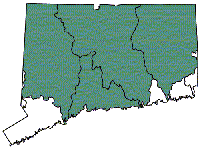Eastern Lampmussel
Lampsilis radiata radiata
Key Features
Size: Up to six inches.
Shape: Ovate or subovate. Mature females usually more rounded toward the posterior ventral margin. Valves slightly inflated, strong, and thick.
Periostracum: Color yellowish-green (juveniles) to yellowish-brown, greenish-brown, or brownish-black (adults). Shell rays numerous and prominent.
Lateral Teeth: Present. Two on the left valve and one on the right valve.
Pseudocardinal Teeth: Present. Two on the left valve and two or three on the right valve.
Nacre: Color white, bluish-white, or pink. Usually lighter in color and much thicker toward the anterior end.
Often Confused With ... Tidewater mucket, yellow lampmussel, and eastern elliptio

External shell

Internal shell, right valve

Hinge teeth
 Habitat: The eastern lampmussel inhabits streams, rivers, ponds, and lakes, where it is usually quite common. It can be found in a variety of substrates but prefers sand and gravel.
Habitat: The eastern lampmussel inhabits streams, rivers, ponds, and lakes, where it is usually quite common. It can be found in a variety of substrates but prefers sand and gravel.
Range in Connecticut: The eastern lampmussel is found in most major watersheds in Connecticut but is particularly common in the Connecticut River watershed.
Conservation: The eastern lampmussel is widespread and abundant throughout Connecticut, and is apparently tolerant of moderate habitat degradation and pollution. It is one of only four species in New England that is considered healthy and stable throughout its range.
Freshwater Mussel Fact Sheets
Eastern Pearlshell
Dwarf Wedgemussel
Triangle Floater
Brook Floater
Creeper
Eastern Elliptio
Eastern Floater
Alewife Floater
Eastern Pondmussel
Tidewater Mucket
Yellow Lampmussel
Eastern Lampmussel
The Freshwater Mussels of Connecticut
Content last updated on January 29, 2014.

